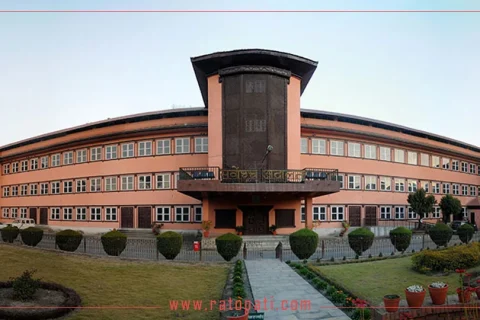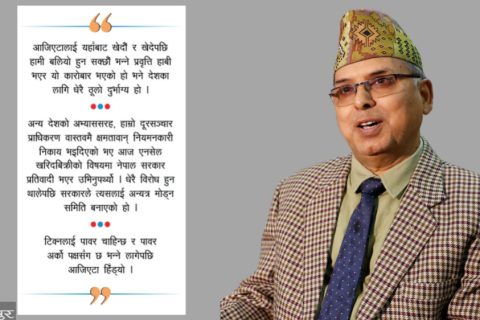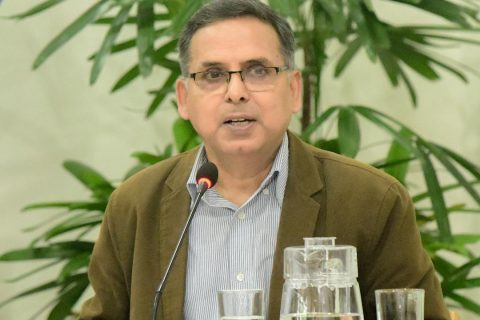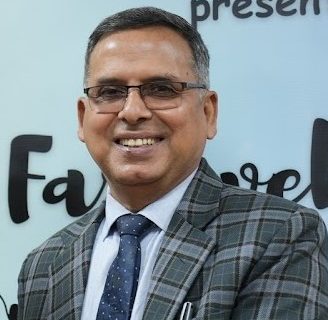“As the session of the Constituent Assembly has been summoned for May 28, the issue of the fate of monarchy appears as the crucial agenda for its first meeting. Although many individual Kings have faced trials in Nepal, this is for the first time the institution of monarchy is facing the vote for its existence. The prominent question now is how the newly elected members of CA- supreme body of public trust- will abolish monarchy. For many followers of seven party alliance, it is now just a simple ritual to declare Nepal as a republic. Will CA abolish monarchy through a proclamation in its first meeting as prescribed by previous nominated interim parliament or wait till the promulgation of new constitution? The first decision taken by the newly elected members of CA will have a far reaching consequence to the country”
“King Gyanendra should help us and himself by abdicating and leaving the Royal Palace. We want his graceful and respectful exit. This is also the mandate of the people,” said CPN-Maoist chairman Prachanda. “If he does not do so, the first meeting of CA will decide his fate.”
“Monarchy will be abolished within the month of Jestha (May14-June 14),” said speaker of Legislature Parliament Subas Nembang. “Within that period, the CA will declare the country as a federal republic. I am confident that without any hindrance, the monarchy will be abolished and the country will be declared republic.”
“The best option for King Gyanendra is to abdicate. If he leaves Royal Palace before the proclamation of Constituent Assembly, it will be better for his future. This is the mandate of the people,” said another Maoist leader Dr. Baburam Bhattarai.
Not only Nepali politicians, political leaders from India- which has the highest security stake in Nepal – too, seem to be determined to abolish monarchy to pave the way for new experiment under the CPN-Maoist party. “Now, we believe that Nepali people will able to establish a democratic republic. Indian people and the government will respect the decision taken by the Nepali people about their political future,” said politburo member of the CPI (M) Sitaram Yechury in his recent visit to Nepal.
All these comments and expressions delivered by political leaders show that abolition of monarchy is their ultimate aim. The interim constitution has been amended in such a way that many people with extreme outlooks think that it is only a ritual now. According to them, the decision has already been taken and what remains to be done is merely to implement it through the parliamentary approval.
Before the monarchy is actually being put into vote, seven party government including the Maoists did everything over the last two years to root out monarchy from the perception of the common man.
According to a lawyer, the intention of putting the monarchy to vote in such a crisis situation is itself an example of how the monarchy is being pushed aside without proper judgment.
“The era of monarchy will come to an end on May 28 when the first meeting of CA will declare Nepal as a republic,” said Krishna Pahadi, a human right activists and member of civil society. “Some may have a ray of hope but I don’t have any doubt about abolition of monarchy and declaration of Nepal as republic.”
In a typical way, like during the period of Cromwell in England when Cromwell and his followers beheaded King Charles- who was put in a stage-managed trial with an aim to remove the monarchy. Like Cromwell and his supporters whose set order was that the King had to die. Their only question was how; by assassination? A discreet poisoning? In the end, they decided to put him to death as per the stage-managed trial.
In a similar way, from Nepali Congress leader Girija Prasad Koirala to Maoist leader Prachanda and CPN-UML leaders Nembang and other leaders of seven party alliances, they have drawn the conclusion that the monarchy must be abolished. Nobody has concern about legitimacy or rule of law.
“Throughout history monarchies have been abolished either through legislative reforms, coups d’etat, or wars. The monarchy is a costly institution to preserve and it has been the subject of considerable controversy since King Birendra and many of the royalties were assassinated in 2001 in a very surprising way,” said Bipin Adhikari, a constitutional commentator.
“In fact, there has been a varying tide of media criticism which has ebbed and flowed prompted by King Gyanendra’s 2005 decision to exercise executive power to deal with Maoist menace, some inappropriate comments and conduct of certain other members of the royal family, and royal pomp and ceremonies. But they are not the reasons behind the abolition of monarchy in Nepal. The reason here is geopolitical. It is happening because the Nepalese monarchs proved for sure that they are not blindly negotiable for money, power and red carpets,” said Adhikari.
“There are many people in Nepal, who think their right to take part in a referendum to decide about the king should have been recognized.”
“Certain things were not possible as long as the monarch stood there as the protector of Nepal’s political independence. This is not to defend the King or his unconstitutional trespasses, but to explain a phenomenon that comes as a challenge of nation building in this country. It is not just the King who is going with a heavy heart. Even the Prime Minister Girija Prasad Koirala, who led the process of the current betrayal to the King, has no choice. The country has no use for him any more,” said Adhikari.
According to the constitutional experts, the interim constitution is unclear regarding the procedure to formally declare Nepal as a republic. Of course, Gyanendra has right to abdicate and personally he can abdicate his kingship but what about the monarchy as an institution?
“Is monarchy a personal property of King Gyanendra? If that is the constitutional logic, personal resignation of CPN-UML general secretary Madhav Kumar Nepal from general secretary of CPN-UML or Prachanda’s resignation from his party or G.P. Koirala from his party presidentship could or should abolish their respective parties. Two different standards are being set by our newly incarnated democrats: one for themselves and another for monarchy,” said a former attorney general and constitutional lawyer on condition of anonymity.
Procedural Issues
If political leaders want to remove monarchy, the parties need to amend the article 159 by two third majorities and replace the article 159 and its proviso regarding the monarchy.
Article 159(2) says the implementation of (transition to) the republic shall be made at the first meeting of the Constituent Assembly. Provided that the Legislature Parliament may implement the republic prior to the elections to the constituent Assembly if the king creates a serious obstacle to the Constituent Assembly Elections, by a motion in the regard passed by at least a two-thirds majority of the existing members of the Legislature-Parliament. Such a motion shall be presented before the Legislature-Parliament in accordance with a decision of the Council of Ministers of the Government of Nepal.
“The proviso cannot override the main provision of the main article 159. To implement the proviso, you need two third majority of CA. However, to implant the main clause, you are saying that no voting is required and simple declaration will do it. What a constitutional logic?,” argued former attorney general. “It is unclear what procedure the first meeting of CA will follow in case of declaring Nepal as a republic.”
As a non-elected body, monarchy is based upon its age old tradition, rules and customs. It is a hereditary institution in which successor is not appointed by his merits but by virtue of a birth in the family. That way a king can decide over his own fate but he cannot deprive his successor from inheriting the throne. As long as monarchy is there in Nepal, this is a valid practice to be observed.
“A democratic society is just society and a democratic government is just government and justice is needed for all. As long as monarchy is there, it also needs justice particularly in the situation like present,” said a political analyst.
Nepal has a long history of monarchy of over two thousand years. Institution of monarchy has been in continuity. Of course, forms and dynasties have changed time to time but it continued. Shah Kings have been ruling since 237 years but before there were Mallas, Lichhivis, Thakuris and Kirats.
Monarchy for Stability
Although politicians and human rights activists have been advocating the removal of monarchy to create new Nepal, they ignore the fact that the monarchy has played its role in stabilizing the society. There are many instances in Asia and other parts of the region where the removal of monarchy brought perennial political instability and devastation.
“It is just a myth that the monarchy will protect Nepal’s integrity and sovereignty,” said senior Maoist leader Ram Bahadur Badal. “The monarchy will meeting of CA.” be buried in the first
The politicians who reached gentlemen’s agreement regarding the role of monarchy betrayed one after another. Whether political leaders betrayed the king, people don’t know. When Girija Prasad Koirala and King Gyanendra reach an agreement on April 22, 2006, there was no agenda in priority to make Nepal as republic. Even highly publicized 12-points agreement didn’t mention abolishing the monarchy.
The prime minister was appointed by the King and he took oath of allegiance in the Royal Palace. “People were, by implication, assured to have continuity with change – continuity of the institution of monarchy and change according to the wishes of the people expressed through CA. Following the dictation from unseen center, Nepal has been pushed into whirlwind of political instability. One does not know where it will lead all the seen and unseen players,” said the political analyst.
Changing Regional Dynamics
Removal of monarchy will not only change the internal dynamics of Nepal but it will also change the dynamics in Nepal’s neighborhood. “After removal of monarchy, India and China will have to see face to face. There will be no safeguard for them,” observed a foreign diplomat based in Kathmandu.
Journalist Sudhir Sharma in his recent news analysis in Nepal weekly predicts emergence of a new situation in which Maoists may be in a position to play Nepal’s two neighbors once they are in power. “After growing Tibetan activities in Nepal, China is desperately searching a new political force which can defend its interest. With the abolition of monarchy, there are no other strong forces other than Maoists to protect Chinese interests,” writes Sharma.
The case of Afghanistan is there where a mistake committed by former Soviet Union in removing the monarchical system finally ruined it. The prolonged political instability and political disorder forced Soviet Union to send its troops to stabilize Afghanistan prompting the entry of American power through Pakistan. Till Jahir Shaha ruled Afghanistan, it had played the role of a perfect buffer state with rise of moderation.
“The mistake which Soviet Union committed by involving itself in Afghanistan brought devastating results for it. India is inclined to commit a same mistake in Nepal which may unfortunately bring similar consequences,” said a political analyst. “If one undermines the stabilizing factor of Nepal, it must be prepared to face the consequences. Nepal’s peace and stability is not only for Nepal but it ensures the peace in the region too.”
Nepal’s position vis-à-vis China and India is like an unalterable logic of geography as described by Sri Lankan president Jayewardene regarding the relations between India and Sri Lanka.
“One is free to do anything but one has to face the consequences also. This applies to the states also howsoever powerful they are,” said the analyst.
King’s Move
As the day is coming closer, King Gyanendra is busy attending marriage ceremonies, receptions and worshipping the gods and goddesses. King Gyanendra worshipped Dakshinkali on Monday.
The monarch is very clear in his commitments to abide by the verdict of the people. Verdict is yet to come by proper means and ways through the CA. “The king is relaxed and not in a hurry of any kind,” said leader of RPP-Nepal Kamal Thapa. “The king abides by the verdict of the people.”
In the beginning, all political leaders were committed to abide by the CA about the fate of monarchy. Later on they deviated from their original stand and declared that the CA will abide what they will say. That way they turned CA as jut a formality to fulfill their political command. “By getting a strong political backing from an unseen center, politicians have taken for granted the popular verdict,” said the analyst.
“Many countries have followed their own way to decide on the fate of monarchy. For example, Australia recognized the right of Australians to take part in a referendum as to the status of the British Queen in Australia. The first question in the 1999 Australian referendum was whether Australia should become a republic with a President appointed by Parliament, a bi-partisan appointment model which had previously been decided at a Constitutional Convention in February 1998. The second question, generally deemed to be far less important politically, asked whether Australia should alter the constitution to insert a preamble. Neither of the proposed amendments passed. It is not the time of Oliver Cromwell of 1649 who overthrew the English monarchy through the Parliament of England. Neither it is 1792 when the French monarchy was abolished (and later restored several times until 1871). We are in the 21st century. If there is democracy and the rule of law for the common people; they decide the turn of events for sure. If not, then it is the outsiders who take the decision. The political institutions of a subservient state, heavily influenced and mesmerized under a planned process, only rubber-stamp what they have been told to do,” said Adhikari.
As such, if leaders of political parties prevail, Nepal’s republic will be under command at any moment since the ground has already prepared for such move.







